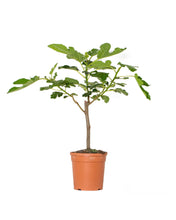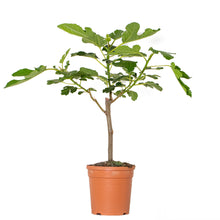Ficus carica, commonly known as the common fig tree, is a deciduous shrub or small tree highly valued for its sweet, edible fruits and attractive lobed foliage. This Ficus species features large, deeply divided leaves and produces unique, pear-shaped fruits, which are actually inverted flower structures. These figs mature from green to various shades of purple, brown, or yellow depending on the cultivar, offering a delicious harvest in late summer or autumn. It is a popular choice for gardens, especially in warmer, sheltered spots in the UK, or grown in containers. It is a member of the Moraceae family.
The genus name Ficus is the Latin word for fig. Carica refers to Caria, a region in Asia Minor from where it is thought to originate.
Light: Ficus carica thrives in full sun. It requires at least six to eight hours of direct sunlight daily for optimal fruit production and healthy growth. A warm, south-facing wall or a very sunny, sheltered spot in a UK garden is ideal.
Water: Water regularly, especially during dry periods and when the fruits are developing. Fig trees prefer consistently moist soil, but ensure good drainage to prevent root issues. Container-grown figs will need more frequent watering, particularly during hot spells.
Soil: It prefers well-drained, fertile soil. It can tolerate a range of soil types, including slightly sandy or loamy soils, and thrives in neutral to slightly alkaline conditions. If growing in containers, a good quality multi-purpose compost is suitable.
Fertilising: Feed with a balanced fertiliser in spring as new growth begins, and then every four to six weeks during the growing season. For fruiting, a fertiliser higher in potassium can be beneficial once fruits start to form.
Temperature: Ficus carica is reasonably hardy in many parts of the UK, especially when established or grown in sheltered locations. Some varieties can tolerate temperatures down to around -10°C (14°F). In colder UK regions, it benefits from winter protection, such as wrapping the branches or moving container plants indoors to a cool, frost-free place.
Humidity: Average UK humidity levels are generally sufficient.
Growth Habit: It typically grows as a multi-stemmed shrub or a small tree. When grown in containers, its size can be restricted through pruning.
Pruning: Prune fig trees in late winter or early spring while dormant to shape the tree, encourage fruit production on new wood, and remove any dead or crossing branches. Pinching out new shoot tips in summer can also encourage fruit development.
Fruiting: Figs typically produce two crops in warmer climates, but in the UK, a single, main crop in late summer or autumn is more common. Fruits ripen on wood from the previous year.
Toxicity: Like other Ficus species, the milky sap (latex) produced by Ficus carica can cause skin irritation upon contact. If ingested by humans or pets, it is considered mildly toxic and can lead to gastrointestinal upset. Keep it out of reach of children and animals, and wear gloves if you have sensitive skin when handling or pruning.



